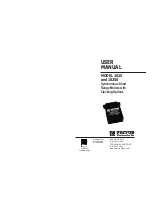
3 Installation
Chapter 3
3
Installation
The installation of the PTC is simple, as all settings are done via software. You need only
correctly configure the cable between the PTC and transceiver.
Figure 3.1:
The PTC-IIex rear panel.
3.1
Power supply
The PTC-IIex has two inputs for its power connections which can be used alternatively.
Either connect via the DC-in supply socket at the rear of the unit, or via the connector for
the short-wave transceiver (Audio). Both connections are decoupled with diodes and
protected against reverse polarity. An input voltage between 10…20 VDC is allowed, the
current consumption depends due to use of a switch mode regulator internally on the
input voltage and also the present processor speed. It is usually around 200 mA at 13.8 V.
Basically the higher the input voltage the lower the current consumption. The power
supply inputs on the PTC-IIex are especially filtered so that harmonics of the switch
mode regulator cannot pass outside the unit. The inputs are protected by a self resetting
fuse.
3.2
The serial interface (RS232/V24)
The
SCS
-PACTOR controller communicates with the computer or terminal via a serial
interface using the RS232/V24 standard.
For communication between PTC and computer, the data format is
8 bits, 1 stopbit, no
parity and half duplex
. The baudrate can either be automatically sensed by the PTC, or
set via a command to a given value (see
SERBaud
).
If the auto baudrate sensing is active after switching on, the PTC waits for keyboard
input. In this condition the tuning display shifts a light, drifting from one edge to the other
and back. It will then wait until either the operator or the terminal program sends an
appropriate character. The PTC reacts to <CR>, <ESC>, and the freely programmable
ESCchr (refer to chapter
). Due to the internal operation of the processor,
the auto baudrate sensing can use only characters with an odd ASCII value: <CR>
(ASCII 13), <ESC> (ASCII 27) or as an example for the freely programmable ESCchr
<Ctrl-A> (ASCII 1), <Ctrl-C> (ASCII 3).
The connection for the serial interface is the 9-pole SUB-D socket on the rear of the PTC.
The connection type is that of a modem (DCE) with a 9-pole SUB-D socket. The PTC
9
Summary of Contents for PTC-IIex
Page 14: ...List of Figures and Tables XII...
Page 30: ...3 Installation 16...
Page 108: ...7 Audio 94...
Page 126: ...8 FAX 112...
Page 173: ...12 SYStest 159...
Page 183: ...14 Circuit Description 169...
Page 195: ...15 Basics 181...
Page 201: ...B Technical Data 187...
Page 202: ...C Layout Appendix C 19 Layout B 1 Motherboard Figure B 1 Motherboard 188...
Page 203: ...C Layout 189...
Page 215: ...Index 202...
















































